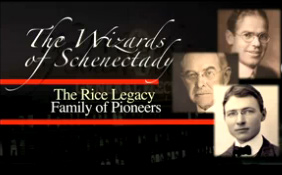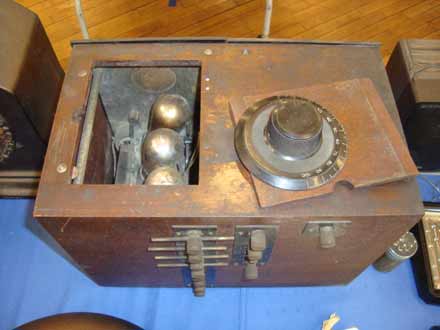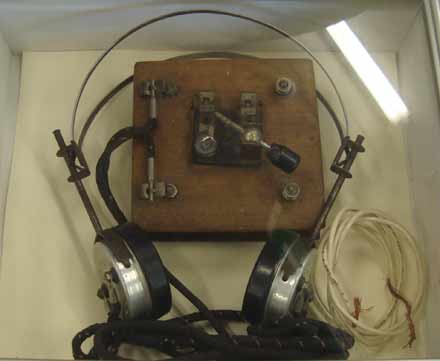Radio
On the science side of things "radiophysics" is the study of certain kinds of radiation, propagation, emission, and how it reacts with other matter. Engineers have been using radio waves to work for humankind for over 120 years. Some engineers have a special talent for understanding radio wave behavior. There are many interesting jobs in this field if you find you have a knack in this area.
If you want to learn the basics of how radios work start with the science, learn about radio physics here.
Another good resource for understanding radio frequency design and science is at Circuit Design, Inc.
1.) Radio history
1.a) 1900-1920s
1.a.1) Technical Developments
1.a.2) Schenectady Developments
1.a.3) Voice Radio
1.b) 1920-1950
1.b.1) Amateur Radio
1.c) 1950-2000
1.c.1) Microwave Transmission
2.) Photos of old radios at the Edison
1.) Radio History
Here is a relatively concise history of radio technology. This is a very large subject so we have provided links in each section for further study.
Pre-1900 History
Radio describes the wireless transmission of voice or other man-made signals. The roots of modern radio are found in the telegraph and telephone business, and the roots of those industries lay in the electromagnetics work by Joseph Henry and Michael Faraday. Just a few years later Samuel F.B. Morse and Alfred Vail developed the telegraph.
See the full background of the telegraph here >
The commercial development of radio began with the development of Marconi's coherer (which was not the first coherer). Although there has been much controversy over Nikola Tesla's claim on early radio much of this is legal posturing/ego and the reality is that a number of pioneers contributed to radio. If we have to pick one name as the 'father of radio' that would be Marconi. Unlike other pioneers of radio components Marconi stuck with radio and pursued the development (and business control) over the long term.
Read about the coherer here >
Below: Edison Tech Center interview with Dr. Pier Abetti, he explains the very basic
principle of how the coherer works:
This era was quite an exciting time as pioneers of radio raged forth in competition to develop long distance transmission and voice transmission.
Pioneers of Radio:
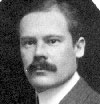
Ernst F.W. Alexanderson - pioneer in wireless and TV transmission 
Ernst Julius Berg - developed two way wireless audio communication. Worked on AC power. 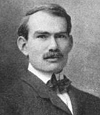
Lee De Forest - Invented the vacuum tube, triode & audion. Improved wireless communication. 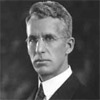
Albert Hull - invented the magnetron (radar) and advanced vacuum tubes (used in many applications) 
CW Rice - developed the loudspeaker, early radar, and other technologies 
Nikola Tesla - improved upon many technologies, most notably AC power. |
Important pioneers of radio in this era include Ernst Alexanderson, Nikola Tesla, H.C. Dunwoody, G.W. Pickard and Reginald Fessenden.
Note that during this period wired telegraph lines were still in widespread use and had been technically integrated with telephone systems although Western Union (telegraphy) and AT&T (Telephone) remained separate financially in order to avoid anti-trust problems.
1.a.1) Technical Developments
|
|
|
1.a.2) Schenectady Developments
Schenectady, New York was the headquarters of General Electric in the early 20th century. As a result this relatively small city separated from the chaotic scene down in the city of New York became a quiet testing ground for many advanced technologies. Many of the world's best engineers immigrated to the US and took jobs at General Electric. Perhaps the most important of all was Swedish engineer Ernst Alexanderson. Early Radio Stations at Union CollegeUnion College in Schenectady was a premier place for the study of electrical engineering in the 20th century. Student radio began there in 1910. The first "wireless telegraph" was set up there by Howard Olwin Thorne and Gustave Huthsteiner. They created a 180 ft. high antenna pole. It had an antenna 225 ft. long and 15 feet wide.
In 1916 a radio shack was built on the side of the Electrical Engineering Building. It was registered with the Radio Association of America. In 1917 it was shut down due to the war but resumed in 1919. The call letters were 2YU. It had the call letters 2XQ for experimental work and 2ADD in 1920. Wendell King was the chief engineer.
1919 - Formation of RCA
The U.S. Navy initiated efforts during World War 1 to keep vital radio patents in the hands of U.S. companies alone. They saw this as a matter of national security. General Electric owned the patents of Ernst F. Alexanderson, who until that point was the only engineer to create long distance voice transmission. The Radio Corporation of America was formed in 1919 as a collaboration of technology between General Electric, Western Electric, Westinghouse, United Fruit Company, and AT&T.
1.a.3) Voice Radio
Timeline of the first regular voice broadcasts:August 20, 1920
- Detroit: 8MK owned by the Detroit News (now WWJ)
began regular nightly broadcasts
October 14, 1920 - Union College, Schenectady: 2ADD
used a 150 watt transmitter and played photographs into a microphone.
It was heard as far away as Hartford, CT. The club promised
to air music every Thursday night for the rest of the academic
year. They did, H.S. Barney department store lend the records
for broadcasts in return for mention on the air.
November
2, 1920
- Pittsburgh: KDKA makes its first regular broadcasts.
KDKA is owned by Westinghouse.
February 20, 1922 - Schenectady: WGY, owned by
General Electric goes on the air.
Source: the book "Encyclopedia of Union
College History" by Wayne Somers 2003
We recommend
you read our page on Ernst F. Alexanderson.
Ernst Alexanderson and Dr.W.R.G.Baker developed equipment for WGY.
WGY became an experimental lab for Alexanderson.
Significant
improvements in radio transmission were made by
Irving Langmuir with his pliotron tube.
We also recommend you also read about Albert
W. Hull. Hull worked on high frequency radio, and created the magnetron.
The magnetron allowed for transmission at microwave frequencies and
lead to radar.
|
The Loudspeaker
While magnetically driven coil speakers had been attempted for some time the development of a modern loudspeaker did not come about until C.W. Rice's prototype in 1921. The challenges which had stopped earlier developers included amplifying electronics and high level understanding of acoustics in the actual speaker materials. The world of acoustics and radio are connected, C.W. Rice not only worked on the loud speaker, but other forms and uses of radio waves including ship and airplane navigation. Right: The first commercially sold amplifier (first "home-stereo"). It sold for $250 in 1926 (about $3000 in today's currency). This amplifier and speaker system was the first to not require a 'horn'. This Radiola Loudspeaker Model 104 could be hooked up to radios and radio broadcasts could be heard by crowds in public places. Today this type of speaker is used in all radios. Recently speakers have gotten smaller thanks to use of magnetically dense rare-earth materials Learn more about speakers on our page here > |
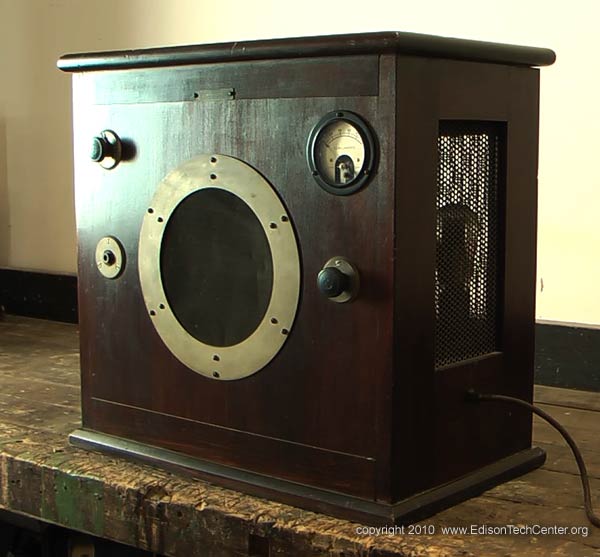 |
1.b) 1920-1950
The commercial success voice radio spurred research and further technical developments.
Edwin Armstrong was one of the most important radio engineers in history. He developed
FM (frequency modulation) radio transmission as well as other apparatus before that.
One of the prominent rivalries in engineering history occurred when Armstrong fought
David Sarnof in the war over FM technology. This war raged from the 1930s until 1954.
Armstrong never lived to see the great success of his invention.
Learn about Edwin H. Armstrong >
1.b.1) Amateur Radio
Amateur Radio has played an important part in the history of radio. All of the pioneers of radio in the 20th century were radio hobbists. Amateur radio provided an outlet in which they could develop skills and test equipment outside of work pressures. Amateur radio operators are issued a license by the country in which they live and follow guidelines on etiquette. They are assigned a 'call sign' which they must use to identify themselves online. If you have an interest in tinkering with radio technology we recommend you go the ARRL website and learn more >
Below is a passage the Schenectady Amateur Radio Association. Many of SARA's members included notable GE pioneers over the years. Wherever you find major workplaces for radio engineers you will find strong local amateur radio clubs.
SARA HISTORY - April
1930
From the Schenectady Union Star newspaper Saturday April 5,
1930
"RADIO AMATEURS TO MEET MONDAY"
"The monthly meeting of the Schenectady Amateur Radio Association
will be held at the YMCA Monday at 8 P.M.
A feature of the meeting will be a talk by Maurice L. Prescott
of General Electric Company an authority on shortwave propagation.
The talk is titled "Amateur Waves and How to Use Them."
and will be a non-technical discussion covering wave assignments
available for amateur use, how to choose the proper wave, and
when to use it.
A short business session and a surprise program will complete the
meeting. All interested amateur radio (operators) are invited."
It should be noted that this SARA meeting announcement was located
right next to the newspaper's radio program listings for the premiere
radio station of the region WGY, who produced most of their own
programming live in those days. Radio program listings on that
particular Saturday included several live dramas, a how-to-do-it
show on "building codes", a string trio music program
and major live music shows such as the "General Electric
Symphony Orchestra" at 9 pm and a local remote broadcast
of Saturday night dancing music from the Hotel Ten Eyck from 11
pm to midnight. Oh and right above the SARA meeting announcement
is a article stating "17 in Troy Brewery Case Plead Not Guilty"
which of course was about arrests made by prohibition officers
during a raid on the Fitzgerald Brothers brewery in Troy the summer
before. It should be explained to those who may not be aware of
the history, that all drinking, manufacturing and sale of alcoholic
beverages was illegal due to Federal Prohibition at that time,
something that was eventually repealed. Elsewhere in the paper
there are several large ads for Atwater Kent radios including
one from the H.S. Barney department store on lower State Street
for the Atwater Kent Model 1055 for the price of $121.00 "less
tubes". That was a lot of money and would come to better
than half a months salary for most families back then. The Schenectady
Union Star and the competing Schenectady Gazette were one of the
two major newspapers in Schenectady of that era. Times were certainly
different in 1930!
This article was written by Daniel W. Whelan, call sign WB2WHD, N2UD
1.c) 1950-2000
The latter half of the 20th century saw the continued growth and refinement of radio technology. Radio became vital to automatic control engineering. Below are some of our pages on this technology:
Remote Control
Control Engineering
Rocket Guidance
General Electric Pioneers:
Roy E. Anderson
at General Electric conducted experiments in space communication. His
first work was in listening for Sputnik in 1956. In the 1960's he worked
in an effort to transmit live television images from the Apollo space
craft. He pioneered satellite navigation systems before GPS.
See the video below to learn about his experiments:
1.c.1) Microwave Transmission
Microwave transmission describes radio transmission of less than 30 centimeters. Generally long radio waves are better for long distance earth-surface transmission (100s or 1000s of km), microwave energy transmission in contrast requires line-of-sight transmission and has certain advantages. Microwave transmission is good for point-to-point wireless connections. It is vital for communications with satellites.
Microwave transmission is the basis for many technologies including doppler radar, defense department radar, backup navigation systems for ships and aircraft and certain types of remote controlled aircraft. Microwave technology is vital for communications, mountain-top microwave towers form 'trunks' which transmit television and voice communications to local distributors.
How it Works:
Most microwaves are generated using a cavity magnetron. Electrons are emitted from a hot
cathode and spin around cavities. Resonation happens and this amplifies the signal to
microwave frequencies.
Klystrons Video: How a klystron tube works, klystrons were used to generate radio waves in powerful radar systems as well as TV transmission:
2.) Photos of radios in the Edison Tech Center collection:
Here are just a few photos of some of the radios on display at the Edison. We have hundreds more in storage and they are displayed at times or can be used by teachers for classes held at the Edison.
|
|
|
|
|
Left and above: Peerless Reproducer Radio |
|
|
|
|
|
|
Related Topics:
|
Vacuum Tubes |
The Microwave Oven |
Lightning and Surge Arrestors |
Remote/Radio Control |
Speakers |
More Stuff |
Sources:
Smithsonian Institute
CyberCollege
Wikipedia
Schenectady Amateur Radio Association
Wizards of Schenectady, The Rice Legacy. 2011. Edison Tech Center
Interview with Rudy Dehn. 2013. Edison Tech Center
Techsplorer - Roy E. Anderson. 2008. Edison Tech Center
Techsplorer - Pier A. Abetti. 2008. Edison Tech Center
Edison Tech Center


